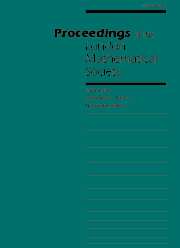Article contents
THE SINGULARITIES OF QUANTUM GROUPS
Published online by Cambridge University Press: 01 March 2000
Abstract
If $\mathbb{C}[G] \hookrightarrow \mathbb{C}[H]$ is an extension of Hopf domains of degree $d$, then $H \twoheadrightarrow G$ is an \'etale map. Equivalently, the variety $X_{\mathbb{C}[H]}$ of $d$-dimensional $\mathbb{C}[H]$-modules compatible with the trace map of the extension, is a smooth $\mbox{GL}_d$-variety with quotient $G$. If we replace $\mathbb{C}[H]$ by a non-commutative Hopf algebra $H$, we construct similarly a $\mbox{GL}_d$-variety and quotient map $\pi : X_H \twoheadrightarrow G$. The smooth locus of $H$ over $\mathbb{C}[G]$ is the set of points $g \in G$ such that $X_H$ is smooth along$\pi^{-1}(g)$. We relate this set to the separability locus of $H$ over $\mathbb{C}[G]$ as well as to the (ordinary) smooth locus of the commutative extension $\mathbb{C}[G] \hookrightarrow Z$ where $Z$ is the centre of $H$. In particular, we prove that the smooth locus coincides with the separability locus whenever $H$ is a reflexive Azumaya algebra. This implies that the quantum function algebras $O_{\epsilon}(G)$ and quantised enveloping algebras $U_{\epsilon}(\mathfrak{g})$ are as singular as possible. 1991 Mathematics Subject Classification: 16W30, 16R30.
- Type
- Research Article
- Information
- Copyright
- 2000 London Mathematical Society
- 2
- Cited by


